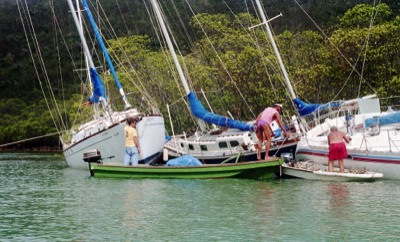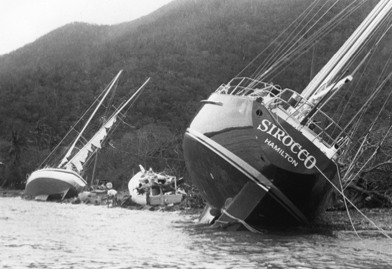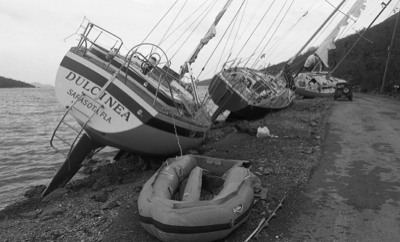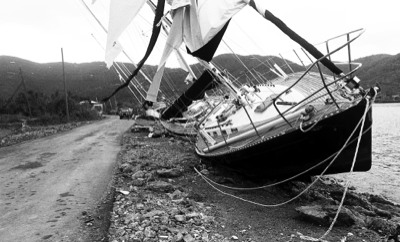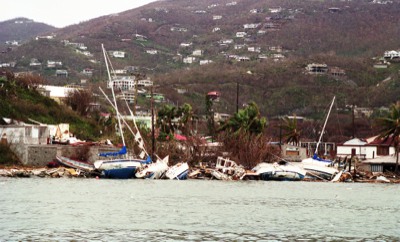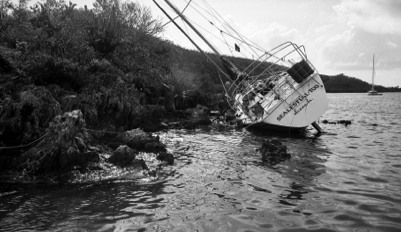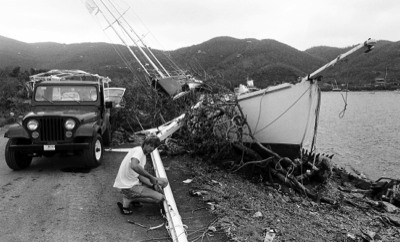Hurricane Comin’
Hurricane Hugo, 1989, Part one:
by David H. Lyman
My three part story of surviving three hurricanes, published beginning in the May 2020 edition of Caribbean Compass magazine. This is Part One
Friday, September 16th, 1989
“Hurricane comin’...” said Ray Pentrack, the manager at the Cruz Bay Marina on St. John, in the US Virgin Islands. He was standing at the meat counter at the grocery store that overlooks this small harbor as I pushed my trolley past.
“What hurricane?” I asked. It was Friday, September 16th, 1989. I’d just flown in from Maine, looking forward to two weeks on Afaran, my 41-foot Lord Nelson cutter. She was moored over in Great Cruz Bay.
“Hurricane Hugo,” said Ray. “We’ve got our hands full with the Hinckley fleet. Can you take care of your boat?” he asked.
“Sure, but what hurricane are you talking about?
“Hugo. She’s a Category 3 now. Should make landfall on Guadeloupe tomorrow, and then hit us sometime on Monday.”
“Shit,” I said under my breath. A Category 3 meant winds well over 100 knots.
“Where are you parking the Hinckleys?” I asked. Ray’s marina managed the Hinckley charter fleet that operated out of Cruz Bay.
“Some, we will take over to Chocolate Hole, some we will double anchor off Caneel Bay. A lot of private boats are heading over to Hurricane Hole on the eastern end of the island.”
“I’ll take a look. You say I have a day or two?”
“Hugo should be here Monday — morning,” he said, and hurried off.
This was the first summer I’d left Afaran in the Caribbean. In previous years, I would sail from Maine to the Virgins every fall, returning to Maine the following spring. But these back-and-forth voyages were taking too much time away from what I really wanted to do — explore the islands. So that spring I had left Afaran on a rental mooring in Great Cruz Bay. I was planning to haul her out on Virgin Gorda in the British Virgin Islands for hurricane season, but it was now too late.
I loaded up the trolley with extra jugs of water, more loaves of bread, canned goods, frozen chicken, peanut butter, jam, UDT milk, cereal, and lots of canned beef stew, my mind in hyper-drive. Was the boat ready? I’d not seen her since May. The fuel and water tanks were full. I had a traditional storm anchor, a 90-pound Yachtsman, under the forward berth, with 200 feet of five-eighths-inch nylon rode, chain and chafing gear. Would that be enough? Was I ready for this?
I piled the bags of groceries, my luggage, and my camera bag in the dinghy, which the yard had left waiting for me at the ferry dock, and motored around to Great Cruz Bay and Afaran.
It was late afternoon when I loaded my groceries onto Afaran’s deck, unlocked and opened the companionway, shoved back the hatch and went below to inspect the bilge. It was dry. I opened the forward hatches to let air through the boat, stripped off my clothes and slipped on a bathing suit, and then set about preparing to get underway. The weather channel on the VHF droned on in the background.
It was like listening to a judge passing sentence on you. I was see-sawing between thrill and dread. Excitement for the impending challenge, fear of the possible consequences. I pushed aside the dread part and got on with my check list: check the engine oil and coolant, turn on the refrigeration, pump the head to make sure it was working. I’d stripped off the sails in May, and would leave them off. With mask, snorkel and flippers, and a large galley knife, slipped over the side to inspect the prop. Yup, it was a solid ball of growth. It took 15 minutes of scraping to get it clean. The hull would need a good scraping too, but not now. When I climbed up the stern ladder to the cockpit, the sun was already setting.
I started the engine and listened to it purr for a few minutes. Turned on the running lights, dropped the mooring pendant, backed away, turned and headed out of Great Cruz Bay, then north around Steven Cay. I turned east as darkness fell. I made it to the beach off the Caneel Bay Resort where I dropped the hook for the night.
Saturday, September 16th
The news on the radio was full of warnings, but you’d never know what was coming from the delightful breeze and blue skies that day. Afaran and I got underway, tow- ing the inflatable, and headed east through The Narrows between the US and the British Virgin Islands. The steep green hills of St. John off to the right dropped straight into the sea. As we passed the island we turned south, then west around Privateer Point and into Round Bay. A few boats were in the process of anchoring in Hansen Bay. I motored farther north into Hurricane Hole, where numerous mangrove coves are tucked into the steep hills on the eastern shore.
While well protected from easterly and southerly winds, there were just too many boats there for me. Yachts were squeezed in together, bows riding to anchors, sterns tied to the mangroves. Crews were tying lines off to the underbrush, deploying anchors, rigging fenders. The scene looked like a boat show. The last thing I wanted was to break loose and hit someone else’s boat, or be hit by someone else. I motored over to Coral Harbor. The anchorage is surrounded by high hills on three sides. The entrance, to the southeast, is guarded by reefs that jut out from shore.
I motored around with an eye on the sounder. I picked out a spot in mid-harbor in 15 to 20 feet of water and dropped the working anchor, a 65-pound CQR on chain, and then dove over the side. With mask, snorkel and flippers I swam back and forth, around the anchor, then around and under the boat, inspecting the bottom. It was all sand — no coral heads or rocks to foul the anchor lines or chain.
The VHF: “A hurricane watch has been posted for Guadeloupe and a hurricane warning has been posted for the Virgin Islands. Hurricane Hugo is a Category 5 event. Winds are in excess of 140 miles per hour.”
The afternoon was spent preparing my boat for the worst. I rigged the 90-pound Yachtsman storm anchor, securing two nylon rodes to 30 feet of chain. I slipped the Yachtsman over the side into the dinghy, motored out and set it, creating a V with the chain on the CQR. To mark each anchor’s position, I affixed a line to an empty gallon water jug. This, I figured, would alert others not to anchor between them.
All afternoon I worked. It was hot, sweaty work. There was no wind in the harbor. overhead, thin, milky clouds were beginning to gather, the only hint of what was coming.
To prepare a long snubbing line for t he chain, I spliced a thimble into one end of a 30-foot nylon line, shackled it to the anchor chain, slipped on a three-foot length of re-enforced hose for chafing gear, tied off the bitter end, and let out 40 more feet of chain, until the snubber took the weight off the chain. Now the nylon line would stretch out before the chain became taut, cushioning the CQR anchor. I rigged chafing gear on the two rodes that ran over the bronze rollers on the bowsprit to thew Yachtsmen, then deployed a third anchor off the port quarter, just in case. I stowed all the deck gear below, but decided to leave the dodger in place, a place for me to hide out of the wind.
While I was eating a PBJ for lunch, the VHF and commercial radio stations on St. Thomas told of what was coming. Hugo would hit on Guadeloupe tomorrow morning with wind gusts to 140 mph. We would begin to feel the effects of the storm on Sunday evening. We could expect winds over 100 mph, with gusts to 140.
Toward evening I was beginning to worry. With little left to do, my mind began to conjure up all sorts of disasters. I began to remove the electronics, the Loran and satnav units. I would take what was valuable ashore with me, hole up in the Moravian Mission church, a stone building, and see what was left the morning after the storm.
There was a growing knot in my belly. Fear comes from anticipating the unexpected, of being faced with something you cannot comprehend, or fail to understand. If you have a good imagination, your mind can come up with all kinds of disastrous situations, but a good imagination should also come up with as many solutions. It’s fear that drives the imagination, until a certain point. Then panic sets in and all creative problem solving ceases; we roll up into a ball and pray for deliverance.
My mind began dreaming a list of possibilities:
• An anchor line chafes through and parts.
• An anchor drags, or all anchors drag.
• Another boat drags down on us, sending both of us to the beach.
• A tornado spins off the eye of the hurricane, picks up my boat and smashes it
on the shore.
• My boat is holed and sunk by another boat.
• We are driven ashore by wind, waves and surge.
The list goes on as the imagination spins out of control.
But, if we can anticipate the worst, we can prepare for it. Preparation is putting “luck” in the bank for when we need it. The Irish call it "Pluck" and it is not luck. Pluck, is luck you create through preparation, training, experience. Did I have it?
When in trouble, seek local knowledge.
I needed to talk to someone . . . .
Click here for Part Two:
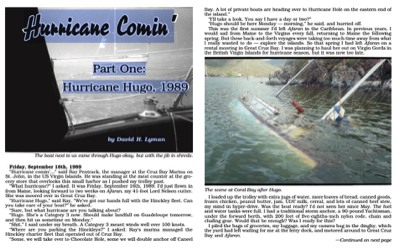
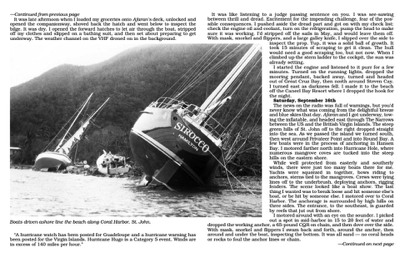
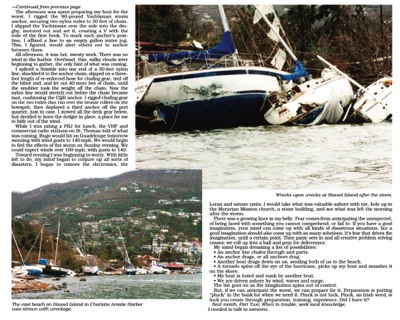
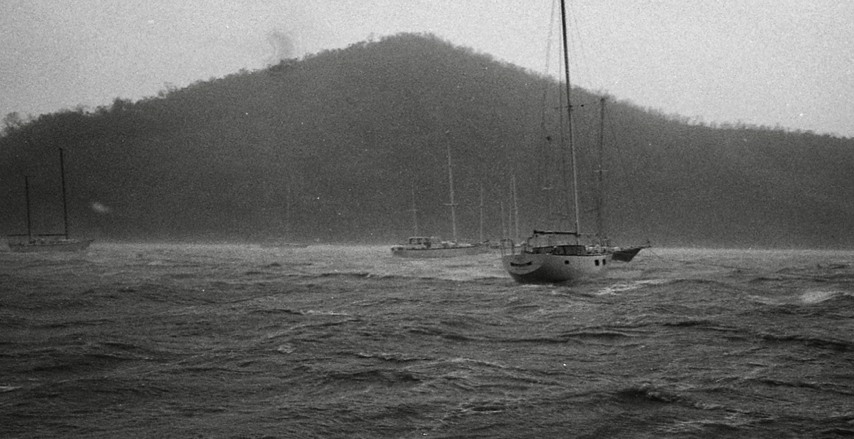
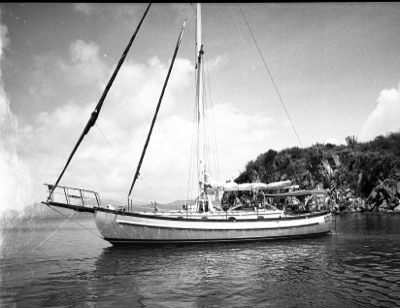
AFARAN, muy Lord Nelson 41 cutter. A deep, full keel cruiser on which I rode our three hurricanes, only to lose her in the forth.
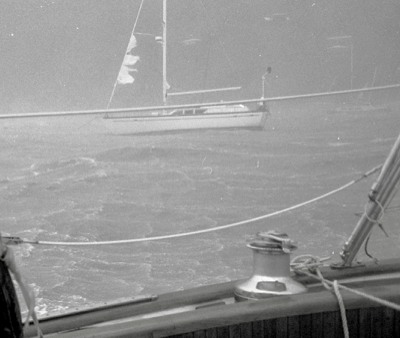
Fifty-fiover (55) yachts were anchored in Coral Bay whejn Hurriucane Hugo came through. There were only 5 of us still at anchore trhe next morning.
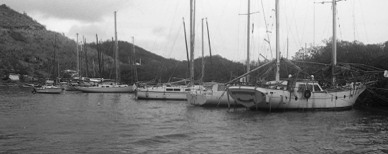
Yachts packed into one arm of Hurricxane Hole on St. John's Eastern End. Below: The morning after, crews sort out the wreckage.
